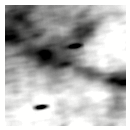|
HIRES can produce good results for relatively weak sources. However, the achieved resolution does depend upon source strength, coverage and background complexity. Following are some rules of thumb for choosing good HIRES targets. Questions should be directed to the IRSA Help Desk. The source should be "sufficiently bright"Unresolved sources should be brighter than about 1 Jy. Extended sources should have emission greater than about 2 MJy/steradian. Also, the local signal-to-noise ratio should be fairly high (~10 or greater) in order to avoid possible complications in baseline subtraction and to help ensure the achievement of high spatial resolution in the region of interest. On the other hand, it is also the case that HIRES can sometimes help in the detection of faint sources by pulling them out of the cirrus background. HIRES can sometimes reveal sources that are in neither the Point Source Catalog (PSC) or the Faint Source Catalog (FSC). Example:
Because FRESCO is very similar to HIRES, an examination of FRESCOs for a given target can often prove illuminating as to the expected behavior of HIRES in the region of interest for less CPU cost and faster turnaround. The target should have good detector coverage.HIRES will work over most of the sky; however, its achieved resolution is quite variable depending, among other things, on the amount of information (coverage) available. It is desirable to have both a moderately large number of scans and as much variation as possible in scan angle. The number of scans available depends in part upon the number of hours-confirming coverages (HCONs) the source received. Most of the sky has three HCONs of survey coverage. Since IRAS was in a near-polar orbit, the coverage also varies with latitude. Higher ecliptic latitude regions are also more likely to have a variation in scan direction. A good target should be covered by two HCONs of survey data or by at least one Additional Observation (AO). The number of HCONs of coverage at or near a given point can be found in the PSC, all of whose sources have at least two HCON s. Information about AOs can be found in the AO User Guide and AO Directory. The AO User Guide is a book available from the IPAC library and both the PSC and a version of the AO Directory are online as a part of the IRSA Catalog Query Engine. In general, more coverage is better, but eventually calibration uncertainties dominate. There are a few sources which have more coverage than is needed. More information can be gained about the coverage of a given nearly point-like target by processing it with SCANPI. SCANPI is the one-dimensional coadder; it also produces detector scan track plots within a 4' window of the input position. Below 1 Jy, results depend strongly on the background complexity. Very bright sources (> 1000 Jy) may suffer from IRAS data features such as hysteresis, saturation and optical crosstalk.
| |||||||||||



